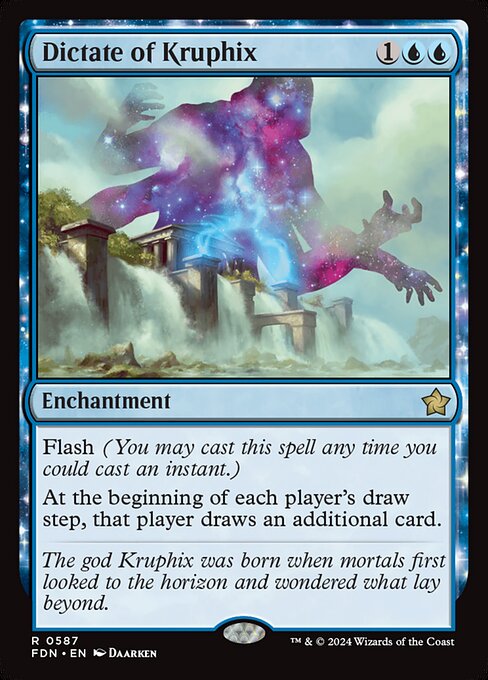
Image courtesy of Scryfall.com
Name Semantics and Competitive Insight for a Blue Enchantment
Blue magic has a long history of “rules and revelation,” and this particular enchantment leans into that tradition with a flourish of cosmic irony 🧙♂️. The name itself—a dictate issued by a god—hints at the power and peril of forcing a shared fate at the draw step. In the grand mythos of Theros and beyond, Kruphix governs horizons and hidden truths, a perfect match for a spell that redraws the map of the game with every player’s draw step. The flavor text about Kruphix’s birth when mortals first asked what lies beyond the horizon invites players to consider how knowledge (and, yes, cards) shapes strategy as much as brute force 🔥💎.
At its core, the card’s name semantics fuse a sense of imperial command with cosmic scale. “Dictate” conveys authority, permanence, and a decree’s blunt efficiency. Pair that with “Kruphix,” the horizon-watching deity, and you get a flavor that feels both lawful and enigmatic: a rule from above, extended into the ordinary cadence of draw steps. It’s a perfect umbrella under which a highly technical effect—“At the beginning of each player's draw step, that player draws an additional card.”—can feel inevitable, almost petitioned by the cosmos itself ⚔️. The mental image is less about luck and more about a grand design you’re suddenly invited to participate in 🎨🎲.
“The god Kruphix was born when mortals first looked to the horizon and wondered what lay beyond.”
In gameplay terms, that horizon-thinking translates to a gamble on tempo and equity. The card’s mana cost of {1}{U}{U} gives you Flash—you can unveil this decree at a moment that denies immediate retaliation, catching opponents off guard with an instant-speed tax on turns while you set up your lines of play. The oracle text is deceptively simple, but the interaction curve is rich: everyone draws an extra card at their draw step. That’s a double-edged blade that can accelerate you toward a win condition or muddy your own plans if you don’t pair it with reliable permission, win conditions, or hand-customization tricks 🧙♂️.
Strategic takeaways: how to make the most of this decree
- Tempo and parity: The spell creates a steady stream of cards for all players. If you’ve built a deck with resilient card advantage engines (think cantrips, card draw, and cyclical effects), you can ride the extra copies while your opponents stumble into stale hands. The trick is to leverage the additional draw to fuel your engine while keeping answers ready for opposing threats 🔥.
- Flash installation: The instant-speed nature lets you drop the decree at just the right moment—perhaps after you’ve drawn into a critical answer or a combo piece. Flash preserves your protection while you sculpt the battlefield, turning potential tempo holes into opportunities ⚔️.
- Deck-building discipline: You’ll want to balance card draw with countermagic, bounce, and win conditions that don’t merely rely on raw cards. The more you can transform extra cards into actual impact (a win condition, a reusable combo, or a threat that scales with mass card draw), the more the card rewards you 💎.
- Commander and multiplayer dynamics: In EDH/Commander, Dictate shines when paired with strategies that benefit from sunk costs and resilience. It’s also a powerful political tool—the “draw more” effect gives you information and initiative, letting you steer the table’s attention while you advance a plan that others will eventually respect (or envy) 🎲.
Flavor and function intersect in one elegant twist: the record of a god’s edict becomes a shared fate, forcing players to adapt rather than simply plan ahead. It’s a reminder that blue can be both a safety net and a catalyst for chaos—precisely the kind of duality that makes MTG’s design so enduring 🧙♂️.
Design, rarity, and modern context
Foundations, the core set reprint line in which this enchantment appears, often showcases familiar blue staples with a twist. This card is a rare, elegantly packaged with Daarken’s evocative art and a frame that reinforces its timeless “legend-in-a-decree” vibe. Its color identity is blue, with a three-mana cost that sits comfortably within many controlling or value-focused shells. While it’s a Foundations reprint, its vintage heart continues to resonate in Commander tables and casual metas alike 🧭.
On the market side, its price point—hovering around a dollar or so in typical markets—reflects both its age and its evergreen applicability. The EDHREC rank places it within reach for players who want to explore deck-building that riffs on shared card advantage, political maneuvering, and the joy of surprising opponents with a well-timed entry. If you’re chasing a collector-friendly moment, the non-foil print is accessible and plenty lively for casual and competitive play alike. The card also has multiple related purchase avenues for those who want to dive deeper into its ecosystem of reprints, rulings, and community discussions 🌟.
Cross-promo note: staging your play on the go
As you prepare for long sessions at the table or quick skirmishes in the wild, keeping your gear safe and dependable is part of the ritual. That’s where a rugged companion can help—your phone case should be as ready as your deck. The rugged TPU/PC shell case linked here keeps your device safe from the inevitable post-game spills, spillover snacks, and the occasional liftoff of your notes mid-battle. It’s a small reminder that even while you chase horizon-bending draws, you don’t have to worry about everyday carry. 🧰📱
Rugged Phone Case TPU/PC Shell
More from our network
- https://blog.digital-vault.xyz/blog/post/dune-chanters-desert-mood-color-light-emotion/
- https://blog.crypto-articles.xyz/blog/post/rayquaza-gx-regional-printings-artwork-differences-explained/
- https://blog.rusty-articles.xyz/blog/post/dusyut-earthcarver-collector-edition-vs-regular-value/
- https://transparent-paper.shop/blog/post/future-proof-your-brand-with-voice-search-optimization/
- https://blog.digital-vault.xyz/blog/post/bp-rp-color-308-reveals-dust-reddening-in-ara/